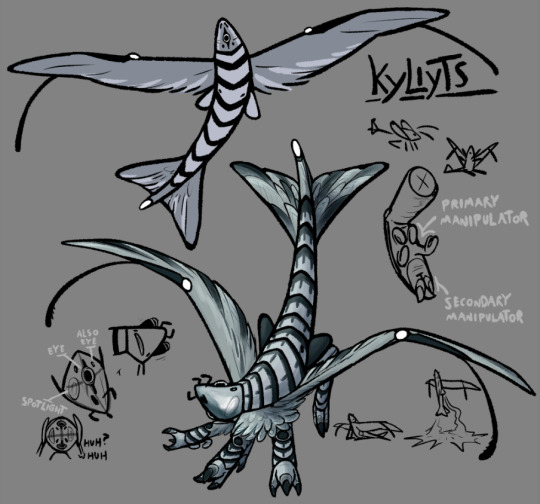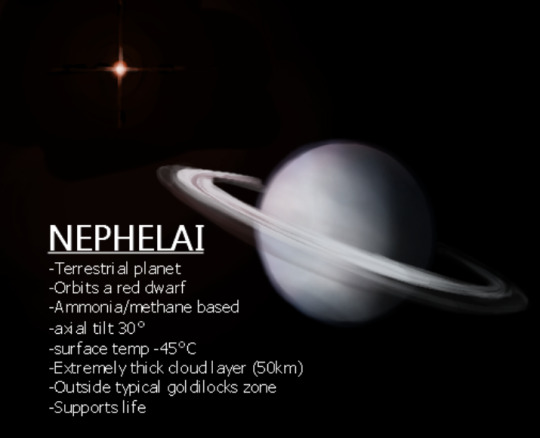#kyliyts
Explore tagged Tumblr posts
Text

hey did you guys know I like specbio? here’s kyliyts!
#speculative biology#xenobiology#speculative evolution#art#kyliyts#i have so much to say about these guys#you don't understand the amount of restraint i'm using#expect more in the future
250 notes
·
View notes
Text
The sun has been an aspect of kyliyt and tipoon horror stories since time immemorial. Up until some very recent technological advances, neither sophont knew much about what laid above the endless clouds of their planet. The only glimpses they really had were through the eyes of hurricanes, where the storm would rip through the clouds enough to let sunlight through. Which is by the way extremely deadly to most Nephelan surface life, due to the radiation and all.
Thus, the sun is often characterized as a force of ultimate destruction. Not really a 'god' as we'd define it, but a malevolent force nonetheless. It was also once thought that the organisms living in the upper parts of Nephelai's atmosphere came FROM the sun, either as its progeny or pieces of it flaking off. Neither sophont had ever seen a living one, just corpses that fell to the surface. Those are also super popular for horror.
Prompt: Horror often reflects the anxieties of the society that made it, write a synopsis for a horror story produced by your fictional society, what anxieties does it reflect?
97 notes
·
View notes
Text

Nephelai is the setting of my speculative biology project, and a very weird planet.
The best way I can describe it is that it’s a cold venus. Its atmosphere is mostly composed of ammonia, methane, and nitrogen in copious amounts, resulting in a powerful greenhouse effect that warms the planet despite its distance from its low-heat star. The resulting cloud cover also blocks all light from reaching the surface.
Cloud formation is spurred by temperature gradients between layers of the atmosphere, which help insulate the planet and promote even more temperature difference. The intense polarization results incredibly frequent, violent storms, which happen to also be the main energy source for surface-bound life.
That’s right, life on Nephelai is electricity based! The combination of cold temperatures, reliable electricity sources, and ammonia-based physiology make this method of metabolism more efficient than typical chemical metabolism, at least for macroorganisms. Energy is gathered and exchanged through raw currents rather than molecular vectors, though organisms do still need to eat to keep their physical cells intact. The line between consumer and producer is blurred here, with many fascinating combinations of both lifestyles.
Anyway here’s a medley of surface organisms, described from left to right. Absolutely not an exhaustive list.

Figure 1: A species of tree analogue. Basically a living lightning rod. Prolific across the planet, and extremely important for all ecosystems they’re in. Owners of the largest battery organs on the planet, which they use to survive for years at a time without storms.
Figure 2: a mobile tree analogue! Part of a whole niche known as ‘stormchasers’, organisms that follow the wake of thunderstorms to harvest energy. Gigantism is common in this niche for the same reason it’s common in the deep sea. Inhabits the plains of the equator’s hurricane band.
Figure 3: Another stormchaser, this one smaller but faster. The ‘head’ is a purely sensory bulb, with the brain being inside the main body. Eats other organisms for the material aspect of its diet.
Figure 4: Mid-sized predator. Uses bioluminescent spots on its knees to hunt by sight, but is overall more of a hearing-based hunter. Their taxonomic class has no external tail-rod, and instead drains using conductive ‘fangs’ in its mouth.
Figure 5: Kyliyts. One of two sophont species. Cosmopolitan, flying pack-hunters that’re allergic to making permanent settlements. Live in inseperable groups of siblings called flocks.
Figure 6: Tipoon. The other sophont species. Rat-sized, very gregarious scavengers/ambush hunters that live in communities of high population density. In the same taxonomic class as Figure 3.
#SPECBIO JUMPSCARE#it's about time i subject all my rainworld followers to more of my mad science#kyliyts#nephelai#speculative biology#spec bio#xenobiology#art#This setup is so improbable but so is Earth. life supporting planets be like that#OH RIGHT ALSO#long post
146 notes
·
View notes
Text
Kyliyt don't have that many hand gestures due to the positioning of the primary manipulators, which are on the back of the forearm and face inwards. Akin to humans, twisting the arms to expose hands can either be a sign of trustworthiness or a threat, depending on what's being held. Holding an arm up and doing a scratching motion with the fingers is a common way to request allopreening from a flockmate.
Tipoon are a highly tactile species and thus use their hand* for a LOT, socially. Beside electroreception-based language, tactile languages are the second most preferred.
Tapping someone with the antenniform is a near ubiquitous greeting gesture. In kyliyt Cities, it's a habit of tipoon living there to hold one or both top arms up & wave to indicate their presence (tipoon are a very small species and kyliyts are visually oriented). Also in Cities, crossing the antenniform and holding out the lower arms is essentially like calling for a cab.
A lot of the other ones are less symbols as we'd define them, since they're touch-based. Tipoon don't have very good vision. Ok so this sounds weird but trapping someone's neck using the upper & lower arms is the polite way of indicating 'I heavily disagree with you and I want to have a measured duel about it', whereas just brushing the neck with the antenniform is 'What you say is interesting'. Like a thumbs up without the implication of agreement. Grabbing someone with the whole hand is either highly intimate or extremely crass, in a non-duel context.
* "Hand" in the context of tipoon means all four arms, the jaw, and antenniform. The individual arms aren't very dextrous, but are arranged to function like one big hand in combination with the lower mandibles.
Antenniform on tipoon are modified fingers that function like antennae, so they're included.
A speculative biology question for the folks out there with critters with cultures & dexterous hands/ other body parts that they use for interacting/ manipulating their environment.
Do they have any kind of gestures or symbols they make using their "hands?"
Think of like a human giving the middle finger, or shadow puppet of a dog, the two finger peace sign, hand waving for greeting? These kinds of gestures!
Perhaps they have a symbolic gesture to represent specific event(s) or being(s) from their cultural histories?
I am just so damn curious to see how other cultures, especially with less human anatomy would approach these gestures. It's not something I see many people bring up!
#ooh boy another one!!#The thing about this is that I haven't gotten to establishing specific cultures yet#and gestures are. well. cultural.#so I'm just vaguing in the general direction of ideas.#ah well!#specbio#kyliyts#tipoon#nephelai#obligatory talk tag#rebog
64 notes
·
View notes